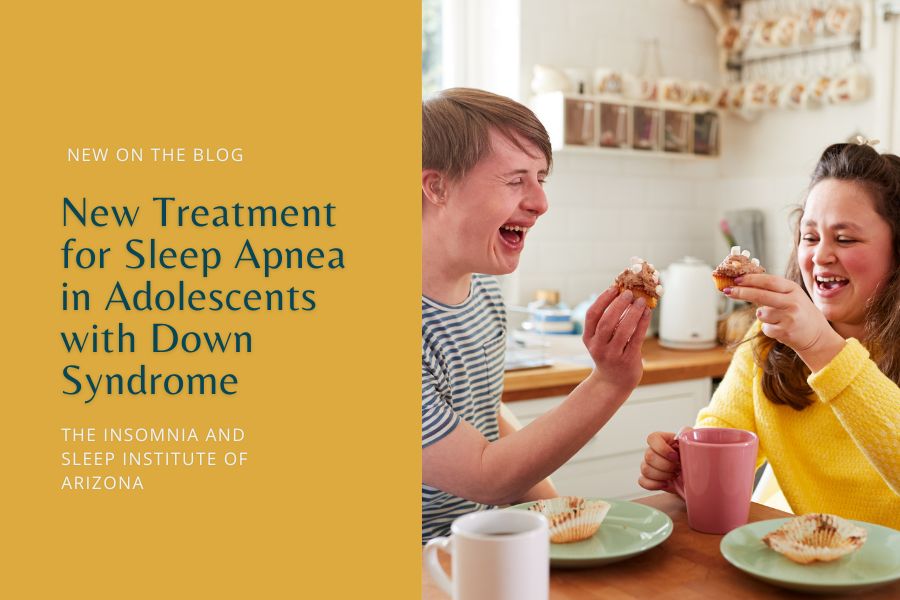Many teens with Down syndrome struggle with sleep apnea, causing poor sleep and health problems. CPAP is often recommended but doesn’t always work well for everyone.
Fortunately, Hypoglossal nerve stimulation is a newer option that shows new chances. It may help improve sleep for those who can’t tolerate other treatments. This approach can be a solution for their overall well-being and quality of life.
What Is Obstructive Sleep Apnea in Adolescents with Down Syndrome?
Obstructive Sleep Apnea (OSA) is a condition in which breathing repeatedly stops and starts during sleep due to a blocked or collapsed airway. In adolescents with Down Syndrome, this condition is more common than in the general population.
Mainly, certain physical and anatomical characteristics associated with Down Syndrome increase the risk of airway obstruction. These include reduced muscle tone, a larger tongue, and narrower airways.
OSA is not good. It wakes the person up multiple times at night. Health problems like daytime fatigue, trouble focusing, behavioral issues, and heart problems may develop. What’s more, Adolescents with Down Syndrome are more vulnerable to these health conditions. So treating OSA can greatly improve their holistic health.
The Prevalence of OSA in Adolescents with Down Syndrome
Research reveals that 50-79% of children with Down Syndrome may have some form of sleep apnea. Obstructive sleep apnea (OSA) being the most common. In comparison, only 1-10% of children in the general population suffer from OSA.
Identifying OSA in adolescents with Down Syndrome can be tough since symptoms often overlap with other behavioral or developmental issues. Look out for loud snoring, pauses in breathing, restless sleep, and daytime drowsiness.
What Is Hypoglossal Nerve Stimulation and How Does It Work?
On the other hand, Hypoglossal Nerve Stimulation (HNS) is a new treatment for obstructive sleep apnea (OSA). It targets weak muscle tone in the throat and tongue, a key cause of airway collapse. The hypoglossal nerve controls tongue movement. In people with OSA, the tongue relaxes too much during sleep, blocking the airway. HNS stimulates the nerve, stopping the tongue from collapsing into the throat. This keeps the airway open while you sleep.
How Does HNS Work?
HNS involves placing a small device under the skin, typically in the chest, along with a sensor positioned against the superficial rib muscle. This sensor tracks your breathing effort. When it detects that you’re inhaling, the device sends a gentle signal to the hypoglossal nerve. This signal prompts the base of the tongue and soft palate to move forward, keeping your airway open and preventing any obstruction.
Patients use a handheld remote to control the device. They turn it on before bed and off in the morning, making it simple to use. HNS reduce the sensory issues that can make CPAP difficult, especially for adolescents with Down Syndrome.
How Effective Is Hypoglossal Nerve Stimulation in Adolescents with Down Syndrome?
To better understand the effectiveness of HNS in adolescents with Down Syndrome, a study below will be explored.
What Did the Study Explore?
The research looked at whether Hypoglossal Nerve Stimulation could be safely implanted in adolescents with Down Syndrome and help treat severe OSA. Researchers selected six adolescents, ages 12 to 18, who had already undergone adenotonsillectomy but still had severe OSA. They focused on testing the safety and effectiveness of the treatment.
These adolescents had an Apnea Hypopnea Index (AHI) greater than 10 events per hour — indicative of moderate to severe sleep apnea. The study tested if Hypoglossal Nerve Stimulation (HNS), an implanted device, could be a better option than CPAP.
What Were the Results of Hypoglossal Nerve Stimulation?
The results were very promising. Over 6 to 12 months, all six adolescents showed significant improvement in their sleep apnea symptoms. Their Apnea Hypopnea Index (AHI) dropped by 56% to 85%. This means they experienced far fewer breathing interruptions during sleep.
Four of the six adolescents had an AHI of fewer than 5 events per hour. This placed them within the range of mild or no sleep apnea. The other two had fewer than 10 events per hour, moving from severe to moderate sleep apnea.
The result showed that there was a reduction in AHI. Meaning that HNS can effectively lower the severity of a person’s sleep apnea. It also leads to better sleep quality and reduces long-term health risks linked to untreated OSA. The children’s commitment to the therapy was strong, with device usage between 5.6 and 10 hours each night. This consistent use further highlights the therapy’s success.
How Did Hypoglossal Nerve Stimulation Improve Quality of Life?
The study measured how Hypoglossal Nerve Stimulation (HNS) improved both sleep apnea symptoms and adolescents’ quality of life. Using the OSA-18 assessment tool, researchers saw significant improvements in daily functioning. Participants also experienced better overall well-being.
The children showed an average improvement score of 1.5, marking significant progress. They experienced better mood, less daytime sleepiness, and improved cognitive functioning. Sleep is needed for health, and better sleep quality positively impacts other areas of life. This is especially true for children and teens who are still growing.
Safety and Tolerability of HNS in Adolescents with Down Syndrome
Safety and tolerability are key when considering a new treatment, especially surgery. In this study, all participants tolerated Hypoglossal Nerve Stimulation well. No significant adverse events occurred. The device was successfully used for long periods each night.
HNS is a great option for teens with Down Syndrome who have sensory sensitivities. Unlike CPAP masks, it doesn’t involve wearing any external devices. Once implanted, it requires very little interaction. This ease and comfort lead to high patient adherence.
Who Is an Ideal Candidate for Hypoglossal Nerve Stimulation in Adolescents with Down Syndrome?
Hypoglossal Nerve Stimulation (HNS) has shown promising results as a treatment option for adolescents with Down syndrome who suffer from moderate to severe obstructive sleep apnea (OSA). Candidates typically have an Apnea Hypopnea Index (AHI) greater than 10. Meaning, they experience 10 or more breathing interruptions per hour during sleep.
Moreover, to qualify, these patients often must show an inability to tolerate CPAP. This is a common issue for adolescents with sensory sensitivities. This therapy is also specifically beneficial for adolescents with Down syndrome who are otherwise healthy and meet specific size and age criteria for the device. While HNS has shown positive results in this group, it’s important to work closely with a specialist to determine if this innovative therapy is the right fit.
How Can Families Decide if Hypoglossal Nerve Stimulation Is the Right Option?
Deciding whether Hypoglossal Nerve Stimulation (HNS) is the right treatment for an adolescent with Down Syndrome who suffers from Obstructive Sleep Apnea (OSA) involves considering several key factors. Here’s a breakdown of what families should assess when making this important decision:
Severity of Sleep Apnea
- HNS is generally recommended for patients with moderate to severe OSA.
- As mentioned earlier, HNS can be an alternative solution for people who think noninvasive treatments haven’t worked
Tolerance to CPAP or Other Treatments
- Adolescents who cannot tolerate CPAP due to discomfort, sensory issues, or non-compliance.
- Children who’ve already undergone adenotonsillectomy but still experience OSA.
Health and Medical History
- Families should discuss the adolescent’s overall health with their doctor to assess the risks of surgery.
- Pre-existing medical conditions or complications should be evaluated before deciding on a surgical solution like HNS.
Surgical Readiness
- HNS involves implanting a device, which means families should be comfortable with the idea of surgery.
- The adolescent must be capable of handling post-surgery care and follow-up appointments.
Cost and Insurance Coverage
- Families should check with their insurance provider and the treatment center about potential out-of-pocket costs.
Consulting with a Sleep Specialist
- A consultation with a sleep medicine specialist can provide a thorough evaluation and personalized recommendations.
- Specialists like us at The Insomnia and Sleep Institute of Arizona can assess the adolescent’s condition. We can determine if HNS is appropriate.
How Does ISIA Support Adolescents with Down Syndrome and Sleep Apnea?
Our sleep specialists assess if you’re a good candidate for HNS and guide you through the process. We provide ongoing support to help you manage your sleep apnea effectively.
Our aim is to improve everyone’s sleep quality and overall health. We provide expert, compassionate care to address the complexities of OSA. ISIA helps families manage sleep apnea with confidence. We stay focused on providing practical solutions and lasting support. Contact us.
References
Arnett, A. (2023, June 30). Improving Care for Children with Down Syndrome and Sleep Apnea. Sleep Review. https://sleepreviewmag.com/sleep-disorders/breathing-disorders/obstructive-sleep-apnea/improving-care-children-down-syndrome-sleep-apnea/
Diercks, G. R., Wentland, C., Keamy, D., Thomas Bernard Kinane, Skotko, B., Vanessa de Guzman, Grealish, E., Dobrowski, J., Soose, R., & Hartnick, C. J. (2017). Hypoglossal Nerve Stimulation in Adolescents With Down Syndrome and Obstructive Sleep Apnea. JAMA Otolaryngology–Head & Neck Surgery. https://doi.org/10.1001/jamaoto.2017.1871
CHAN, J., EDMAN, J. C., & KOLTAI, P. J. (2004). Obstructive Sleep Apnea in Children. American Family Physician, 69(5), 1147–1155. https://www.aafp.org/pubs/afp/issues/2004/0301/p1147.html
Note: The findings of this study above should not replace professional medical consultation.





